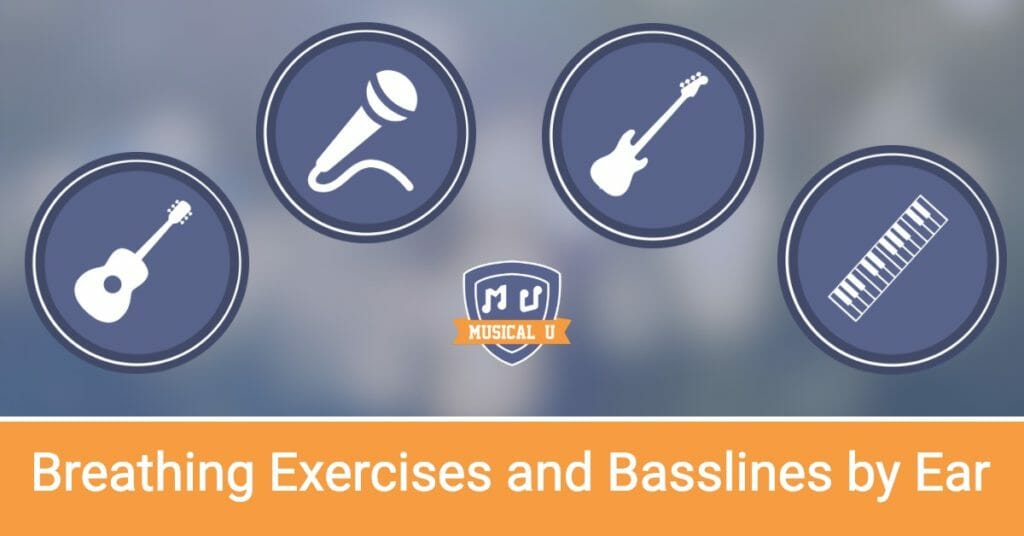Learning music by ear involves many components. Last month, we focused on the process of learning melodies, and this month we’re learning about basslines.
Well, that sounds fine for bass players, but why do guitarists and pianists need to learn basslines? Wouldn’t chords be the most likely next step?
There are several advantages to focusing your attention on the bassline, whether you’re actually going to play it or not. First of all, the bassline often tells us what the chords are, or gives us a pretty good guess. And it’s easier to hear that single note rather than a whole chordful of notes all at once.
Bass-ic Training
The bass also frequently follows more or less predictable patterns that can help you learn a whole chunk of music in one fell swoop. That’s because the bass plays a specific role in the harmonic and rhythmic universe of a song.
Harmonically, the bass often outlines the roots of the chords, and then, depending on the song or the genre, more notes help to transition between these roots. Rhythmic patterns often follow genre guidelines – strong downbeats in country, walking bass in jazz, more active lines in funk, etc.
Combining this theory knowledge with some pattern practice on our instruments puts our ears on alert to capture these patterns in the music we listen to every day.
And for singers…
This month, Singing Pro Clare Wheeler continues with the second of her Resource Packs on breathing for singers.
Singing
In Breathing, Part 1, Singing Pro Clare Wheeler provided a step-by-step routine to relax and strengthen your breathing cycle as you prepare to sing. This month, Clare integrates that sequence with vocal warm-up exercises:
Including:
- An efficient practice regime that can be done regularly to improve breath support and stamina.
- Warm-up stretches to improve posture.
- Locating the abdominal muscles that maximize the breath.
- Training your body to expand the ribcage.
- Adding in held notes, scales, and arpeggios in the best way to build both breathing and tone.
- Working with vowel sounds, and the best vowel to use for these exercises.
- MP3 backing tracks to add more pleasure and musicality to your vocal warmups
As a busy touring professional, Clare shares with us the go-to sequence that helps her to stay vocally fit and prepared even in the midst of a busy performing schedule.
Bass
Basslines. Isn’t that what we do as bass players every day? Yet too often we have our bass blinders on and aren’t as connected with the chords and melody as we could be. Steve Lawson, our Resident Pro for bass, takes an innovative approach to learning basslines by ear. By learning to construct basslines with the tools of theory and our fretboard patterns, we can more easily hear them in the music we love, and more quickly put them under our own fingers:
Including:
- A “magic triangle” for you to connect your theory knowledge, instrumental skills, and the actual sounds of the music you create.
- How the bassline integrates with the harmonic structure of a song.
- Breaking down the most useful bassline patterns and archetypes.
- Mapping these patterns and archetypes on your fretboard.
- Beautiful MP3 tracks to exercise your new bassline understandings
By using theory to map out common bassline patterns on our instrument, we quickly become better at hearing and identifying them “out in the wild”. Then rather than painstakingly working out each note, we can recognize an entire pattern and quickly duplicate the whole thing on our bass.
Piano
Bass is cool. There’s no doubt.
Pianists don’t have to miss out on that essential element.
The bass part is a great place to start when learning the harmony (chords) of a song by ear. This is because for the most part – and certainly, in basic popular songs – the bass part is the root note of the chord. Piano Pro, Ruth Power, shows how you can recognize and play bass patterns by ear:
Including:
- How to tune your bass-ic instinct to hear the chord progression.
- “Fishing” for bass.
- How to rank the chords and scale degrees to narrow down your note choices.
- The five bass movement shortcuts that will accelerate your grasp of basslines in the music you love.
- Three powerful exercises for learning basslines by ear.
- 17 MP3 tracks that illustrate and provide practice opportunities for each exercise.
With Piano Pro Ruth Power, you will combine hands-on bassline practice with learning to grab these patterns by ear and feed your musical hunger with juicy chunks of bass.
Guitar
You may be surprised to learn that there are tons of benefits to learning basslines by ear, even as guitar players. It’s an important skill to develop if you want to be able to see the big picture of a song. The entire dynamics of the melody and chords can be unlocked by the understanding the bass.
Resident Pro Dylan Welsh shares the many ways learning basslines by ear will expand your playing and musical awareness:
Including:
- How learning basslines by ear will improve your musicianship and ability to learn chords by ear.
- How it can actually bring about benefits to your guitar playing.
- Dylan’s own process for figuring out bass lines.
- How to figure out chord progressions (or at least get close) using only information that the bass line provides you.
- Five crucial exercises with MP3 tracks to take you step-by-step through the process.
Coming up next month…
Musical U’s Resident Pros continue to explore the play by ear process with chords, and matching pitch for singers.
Interested in getting access to these resources and much more, with an Instrument Pack membership? Just choose that option during checkout when you join Musical U, or upgrade your existing membership to get instant access!







